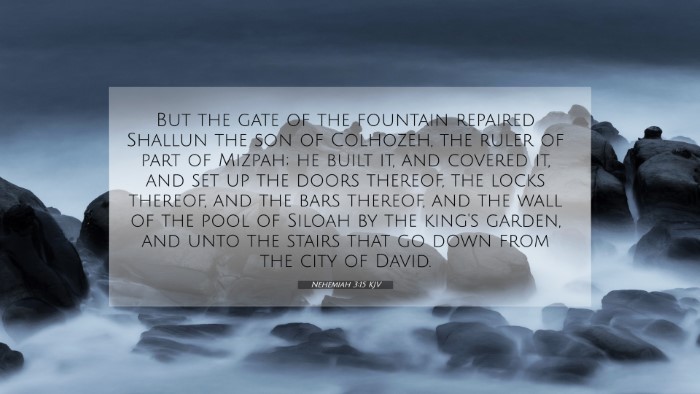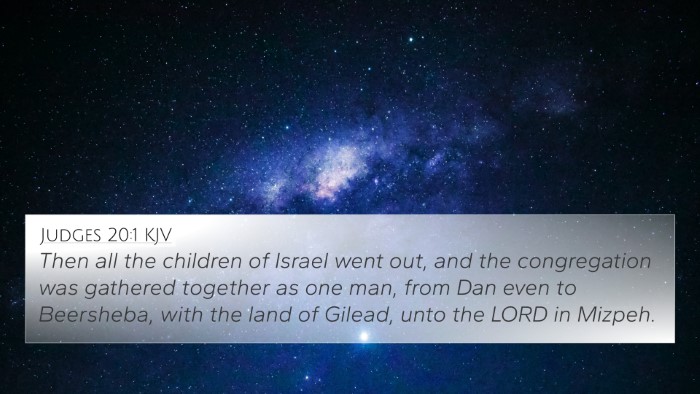Understanding Nehemiah 3:15
Verse Text: Nehemiah 3:15 - "But the gate of the fountain repaired Shallun the son of Col-hozeh, the ruler of part of Mizpah; he built it and covered it, and set up the doors thereof, the locks thereof, and the bars thereof."
Context and Historical Background
The Book of Nehemiah chronicles the return of the Jewish exiles from Babylon and the rebuilding of Jerusalem's walls. In chapter 3, we see a detailed account of the various sections of the wall and the individuals who took part in this significant task. Nehemiah's leadership and the cooperative spirit of the community played a crucial role in the restoration of their homeland.
Commentary Insights
The following summarizes insights gathered from various public domain commentaries:
Matthew Henry's Commentary
Matthew Henry emphasizes the importance of individual contributions in communal tasks. He notes that Shallun, identified as a ruler of part of Mizpah, took on a vital role in repairing the gate of the fountain. His actions reflect a spirit of leadership and responsibility. The “gate of the fountain” is significant as it may symbolize life-giving water, representing both physical sustenance and spiritual renewal.
Albert Barnes' Notes
Albert Barnes points out the organizational structure of the rebuilding efforts. Shallun's position as a ruler signifies that leadership involves taking action. Barnes highlights the thoroughness of the repairs—covering it, setting up doors, locks, and bars—indicating a desire for security and functionality. This comprehensiveness serves as an example for believers in taking care of their spiritual lives and communities.
Adam Clarke's Commentary
Adam Clarke elaborates on the specifics of the gate's restoration. He suggests that the fountain symbolizes the flow of blessings and the need for protection in both physical and spiritual realms. Clarke interprets the construction as a restoration of hope and purpose among the people of Jerusalem, showcasing the collective effort required to realize their aspirations.
Key Themes and Spiritual Applications
This verse showcases several themes that resonate with contemporary readers:
- Community Involvement: The passage highlights the significance of collective effort in achieving a common goal.
- Leadership: Shallun's role as a ruler illustrates the responsibilities of leaders to engage actively in their communities.
- Spiritual Renewal: The gate of the fountain symbolizes the importance of spiritual nourishment, which is foundational for a flourishing life.
- Security in Faith: The provisions made for locks and bars reflect the need for both physical and spiritual safeguards.
Bible Verse Cross-References
Nehemiah 3:15 can be connected to various other scriptures, highlighting themes of restoration, community leadership, and spiritual sustenance:
- Nehemiah 2:17: "Then said I unto them, Ye see the distress that we are in, how Jerusalem lieth waste, and the gates thereof are burned with fire: come, and let us build up the wall of Jerusalem, that we be no more a reproach."
- Proverbs 27:17: "Iron sharpeneth iron; so a man sharpeneth the countenance of his friend."
- 1 Peter 4:10: "As every man hath received the gift, even so minister the same one to another, as good stewards of the manifold grace of God."
- Philippians 2:4: "Look not every man on his own things, but every man also on the things of others."
- Galatians 6:2: "Bear ye one another's burdens, and so fulfill the law of Christ."
- Ezra 3:10: "And when the builders laid the foundation of the temple of the LORD, they set the priests in their apparel with trumpets, and the Levites the sons of Asaph with cymbals, to praise the LORD, after the ordinance of David king of Israel."
- Isaiah 58:12: "And they that shall be of thee shall build the old waste places: thou shalt raise up the foundations of many generations; and thou shalt be called, The repairer of the breach, The restorer of paths to dwell in."
Conclusion
Nehemiah 3:15 embodies essential lessons about participation, leadership, and the restoration of community and faith. The detailed account of Shallun’s work demonstrates how each individual’s contributions play a crucial role in the broader narrative of rebuilding as a community of faith. Through cross-referencing, we understand that these themes echo throughout scripture, inviting us to reflect on our own roles in spiritual renewal and communal health.

















